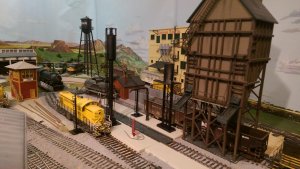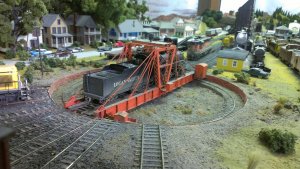How do you do it? I was wondering what the most common ways of turning your loco's around were on our model railroads. In my case , I think I may have to go with a turntable . I cant , at this point put in a reverse loop and a Wye would take up more real estate than I care to use . I could just use the 5 finger crane method 
You are using an out of date browser. It may not display this or other websites correctly.
You should upgrade or use an alternative browser.
You should upgrade or use an alternative browser.
turning your trains around
- Thread starter jim81147
- Start date
Iron Horseman
Well-Known Member
The first question to me would be why does one want to turn a train around? Why could dictate the how.How do you do it? I was wondering what the most common ways of turning your loco's around were on our model railroads.
In your case, with limited space and if it's only the loco you want to turn, then a turntable is the way to go. Otherwise the 5 finger method (also known as the H.O.G.) If a whole train, then either the reverse loop or wye would be needed. Can you build just the upper part of the wye on your layout and have the tail track on a hinged dropdown, that gets supported by a hinged tripod leg that also drops down to support the track piece when required and folds out of the way when not in use.
Horseman , I would like to run trains both ways on my layout. I think this would keep switching more interesting and more varied .
Toot , HOG = hand of god ??? I am just looking to turn the locos . That is a good idea about the fold down but I think that my aisle space may be to limited .
Toot , HOG = hand of god ??? I am just looking to turn the locos . That is a good idea about the fold down but I think that my aisle space may be to limited .
Selector
Well-Known Member
I build a returning loop managed by a PSX-AR. Unfortunately, it means fashioning a bridge that runs diagonally across my operating pit. It will swing up and lock into place.
Why do I turn trains? To ensure the flanges on both sides of the locomotives and rolling stock get equal wear. If they always go around my folded loop, basically an oval that is stacked with an overpass, the flanges on one side will get worn paper thin and I'd have to replace the wheelsets with perfectly good wheels on one side.
Additionally, I like to see my trains run up and down my grades, and across bridges and into tunnel portals, on both ends.
Why do I turn trains? To ensure the flanges on both sides of the locomotives and rolling stock get equal wear. If they always go around my folded loop, basically an oval that is stacked with an overpass, the flanges on one side will get worn paper thin and I'd have to replace the wheelsets with perfectly good wheels on one side.
Additionally, I like to see my trains run up and down my grades, and across bridges and into tunnel portals, on both ends.
Sounds like a turntable's you're only choice at the moment. Strategically placing it could be the challenge.
I have been thinking about a turntable for a while . I do have a place where I think I can fit one . It was originally supposed to be a small town but yard track and maintenance facilities seem to be creeping over that way and using up more of the proposed area . maybe I should just accept that the original plan is going to be changed ( hey , now there is a first !!! )
It's nice to have town scenery. For me, the trains and their operations come first when it's a matter of using space to the greatest advantage.
It depends totally on the layout and how it is set up to run. Mine is rather small (10x18') and set up for twice around the room around the wall continuous running with staging under yard. It has no provision for turning trains at all - just running trains and some switching in the yard of industries. Hopefully in a couple more years I will be able to move into a home with more space and at that time I may build in turning ability.
montanan
Whiskey Merchant
I use a turntable. My layout is a point to point layout, but with the use of hidden staging tracks, I can run train continuously. I have a turntable, roundhouse and engine facilities at each end of the main line.


My main line is short for the room I have available, but the layout was built mainly for switching and this creates more operation for me.


My main line is short for the room I have available, but the layout was built mainly for switching and this creates more operation for me.
logandsawman
Well-Known Member
Horseman , I would like to run trains both ways on my layout. I think this would keep switching more interesting and more varied .
Toot , HOG = hand of god ??? I am just looking to turn the locos . That is a good idea about the fold down but I think that my aisle space may be to limited .
If you are switching, you can drop off the caboose before a siding and get the locomotive to the other side of the string using the siding or "run around" track. Of course, you would want to keep this area clear all the time. It is kind of a dosey-do to get the caboose moved as well, but it works. You will be limited to the size of train by the length of the siding.
Happy Curmudgeon
Member
I pick them up with hand, while making crane noises and turn them around.
The crane noises are a vital step.
The crane noises are a vital step.
I have two reverse loops in my layout (stacked loops) so i can turn trains at both A and B points of my mainline. There are cases though were i am questioning the benefit of turning the train around, especially when my layout gets expanded. Unless i am dealing with passenger trains, my freights get no benefit for being able to reverse themselves as their consists should change every time they appear on the layout. Have in mind that i am dealing with diesel era only and in most cases with consists of locomotives. Steam running may be different.
Having read about operations (haven't operated yet myself) and experimenting with alternative layout plans, it seems that it would not be a bad idea to have a point to point plan with through staging (same staging yard for both ends of the mainline so that continuous running is an option for display purposes) with provisions to be able to switch engines/consists in the said staging.
Having read about operations (haven't operated yet myself) and experimenting with alternative layout plans, it seems that it would not be a bad idea to have a point to point plan with through staging (same staging yard for both ends of the mainline so that continuous running is an option for display purposes) with provisions to be able to switch engines/consists in the said staging.
montanan
Whiskey Merchant
You probably don't need to turn around freight trains as you can just move the caboose to the other end and turn a locomotive using a turntable. Passenger trains are a different story. My layout being a point to point requires a bit of for me. My trains aren't long, mainly a combine and a coach behind a locomotive or an RDC with a club bar behind it from time to time. The combine should be turned as well as the RDC and club car. With a turntable at each end of the run, it just requires a few moves and being that I'm a lone operator, it gives me something to keep me busy. I do run one tourist train consisting from three to six cars, but this passenger train does not need turning as it's final destination is "off stage" in hidden staging tracks.
Iron Horseman
Well-Known Member
So you want to change the direction during an operating session. Since you don't have room for a wye or a reversing loop then the answer is a turntable.Horseman , I would like to run trains both ways on my layout. I think this would keep switching more interesting and more varied.
Iron Horseman
Well-Known Member
That is prototypical even in the steam era. Looked really strange having a locomotive going backwards on the front of the train, but it was done.What I sometimes do is travel to a town, do what switching is necessary and then tack the caboose on the other end of the train and have the locomotive run around to the other end and back up to the yard where it started.
Well, it's your railroad, so you can run it however you see fit. However, as others have pointed out, you may not need to turn your locomotives at all. Many regionals and shortlines don't turn their engines, they just run them whichever direction is needed. If you have more than one engine, (not common on model railroads with short trains) you put them back to pack so you have a forward facing unit in each direction. Even with just a single engine, it was quite common to not turn them. In fact, for some switch engines, such as an SW1500, running them backwards is nicer than running forwards as you have much better view. Forward and backward is defined by the engineer's position, which is on the right side of the locomotive. They're designed so that forward is with the hood in front and cab to the back. But when running backward you have the nice big glass windows with a great view. This led some railroads to intentionally run them "backwards" (from a mechanical point of view, they don't care which way they go) even if they had multiple units in one train, such as in this photo:
http://www.railpictures.net/viewphoto.php?id=415346
Steam locomotives were more commonly turned than diesel locomotives, but it depended on the situation and railroad. Logging railroad for example would often run the engine facing one direction at all times. They used locomotives that were designed for this, such as geared locomotives and 2-8-2's or 2-6-2's. Tank engines were also common. Then again, many used second hand locos, so you never quite know what you'll see.
http://www.railpictures.net/viewphoto.php?id=415346
Steam locomotives were more commonly turned than diesel locomotives, but it depended on the situation and railroad. Logging railroad for example would often run the engine facing one direction at all times. They used locomotives that were designed for this, such as geared locomotives and 2-8-2's or 2-6-2's. Tank engines were also common. Then again, many used second hand locos, so you never quite know what you'll see.

